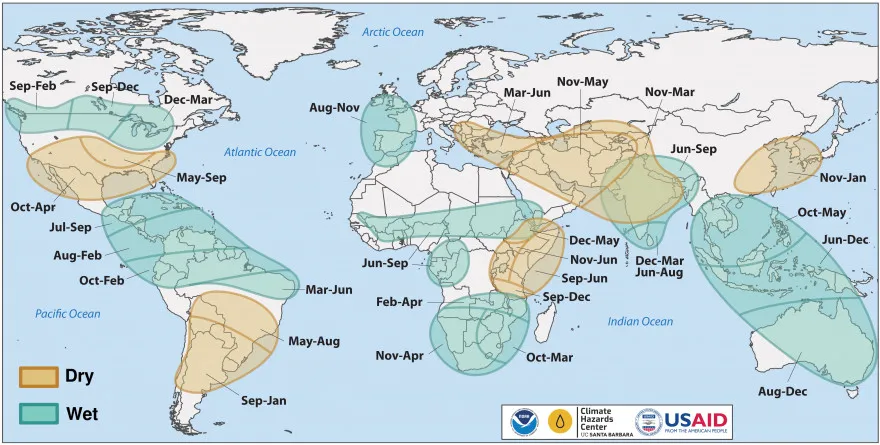La Niña Conditions Confirmed in 2025
La Niña conditions have re-emerged in the Pacific Ocean, as reported by the National Oceanic and Atmospheric Administration (NOAA) on January 9, 2025. This phenomenon is part of the El Niño Southern Oscillation (ENSO), which influences global weather patterns. The emergence of La Niña is characterised by below-average sea surface temperatures in the central and eastern Pacific, contrasting with the warmer conditions typically associated with El Niño.
About La Niña
La Niña is a climate pattern that represents the cool phase of ENSO. It occurs when cooler ocean temperatures dominate the central and eastern tropical Pacific. This phenomenon typically leads to increased rainfall in some regions and droughts in others. La Niña conditions are often linked to stronger trade winds, which push warm water towards the western Pacific.
The ENSO Cycle
The El Niño Southern Oscillation comprises three phases – El Niño, La Niña, and neutral. El Niño is characterised by warmer sea surface temperatures, while La Niña features cooler temperatures. These phases occur irregularly, typically every two to seven years. Each phase lasts approximately one year, but La Niña events may repeat and persist longer than El Niño events.
Mechanisms Behind ENSO
The Bjerknes feedback mechanism plays important role in ENSO. This process involves interactions between sea surface temperatures and atmospheric winds. Weaker easterly trade winds during El Niño allow warm water to accumulate in the eastern Pacific. Conversely, stronger trade winds during La Niña enhance the upwelling of cooler water. The exact triggers for these oscillations remain a subject of ongoing research.
Global Climate Impacts
ENSO impacts global weather patterns. El Niño can lead to increased global temperatures and extreme weather events, such as heavy rainfall and flooding in some areas. In contrast, La Niña often results in cooler temperatures and can cause droughts in regions reliant on consistent rainfall. The effects of these phenomena are particularly pronounced in developing countries bordering the Pacific Ocean, where agriculture and fishing are heavily dependent on stable weather conditions.
- ENSO affects global weather patterns every 2-7 years.
- Bjerknes feedback was named after Jacob Bjerknes in 1969.
- La Niña typically leads to increased rainfall in India.
- El Niño events can spike global temperatures for about a year.
- The last La Niña occurred from 2020 to 2023.
Current Forecast and Implications
Meteorologists predict that the current La Niña will be weak, with limited impact due to warmer ocean temperatures persisting for over a year. The Nino 3.4 index, a key indicator of ENSO conditions, is not expected to drop . Experts note that this La Niña’s emergence may be delayed, raising questions about its potential effects on global weather patterns during the current season.
Month: Current Affairs - January, 2025
Category: Environment Current Affairs








ROBIE JAWAHARLAL
January 14, 2025 at 4:06 amThanks For This Informative Article.
This Is What Is Required For Survival Of Our Species In Context With Global Warming And Similar Geological Phenomenon That Are Often Associated With Otherworldly Influence And/Or Witchcraft & Superstition, Due To Lack Of Practical Knowledge.
Abdul Rashid Naik
January 14, 2025 at 8:11 amI request all world please ban on plastic made items like carry bags which destroys our earth and water resources I am from Kashmir
mohit bairagi
January 14, 2025 at 10:53 amgk from
Ramachandra Rao Mylavarapu
January 14, 2025 at 4:08 pmCertain State Governments in India are not taking proper measures on environmental issues
Gentile Chasaya
January 17, 2025 at 11:10 amVery informative and eductative piece of work. Keep it up.
The issue of baning plastic bags and disposable plastic packages for beverages require global pressure groups and advocacy especially in developing countries. Plastic pollution is a huge environmental, economic, health and social curse.
Farzan
January 14, 2025 at 12:55 pmLet us make a better place to people who will come after we go.
Anil Kumar
January 14, 2025 at 6:35 pmIs India and other countries which fall in tropical regions prone to extreme weather conditions due to La Niña?If it does,how long would the conditions prevail?
Omar
January 14, 2025 at 6:48 pmHello please correct the map of Morocco it is not devided as you mentioned it.
Thanks
Greg
January 15, 2025 at 6:16 amFuck it…. we have to live for now. The climate bullshit is just that…bullshit!! People need to grow up and think for themselves!!!
David Mwangi Njuru
January 15, 2025 at 10:16 amLet us always preserve the flora and fauna we have and every day mentors our children and grandchildren and all others near us on conservation of mother nature resources.
Larry Wyne Bin Tigur
January 15, 2025 at 3:33 pmHopefully amen 🙏